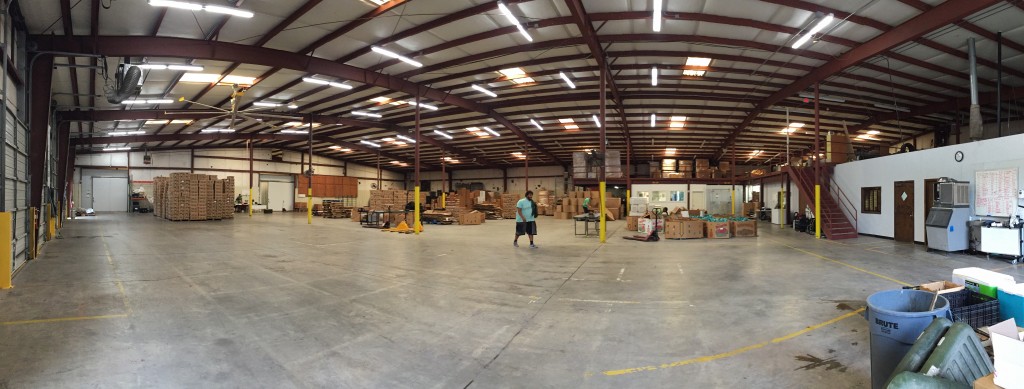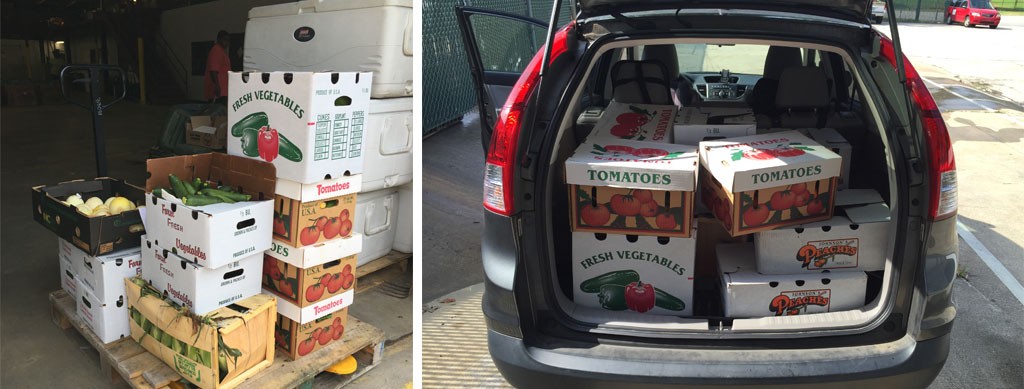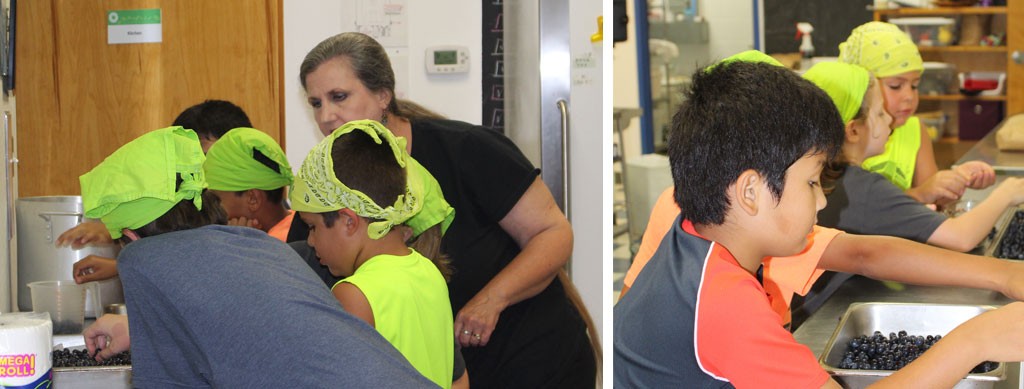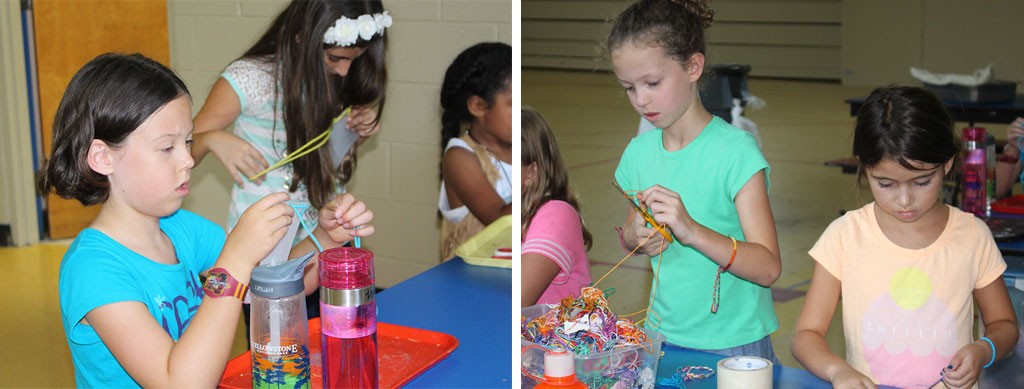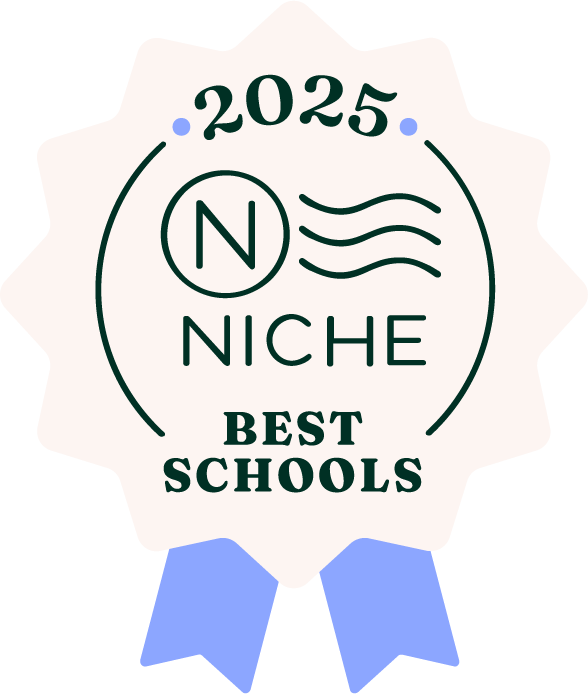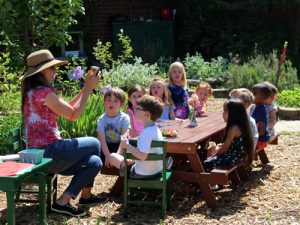
Sara Stratton leads Primary students in making dressing for their strawberry spinach salads.
Springtime is always joyful in Greensboro Montessori School's organic gardens. Winter buds swell and burst, capturing the eyes and hearts of community members, no matter their age! Flowers of all kinds call to us and to our pollinator friends, and sooner than we realize, we reach the height of the season.
This year brought a colder and wetter forecast than in the past. We’ve still yet to harvest our first sugar snap peas, but the strawberries and spinach are out with a vengeance! We continue to enjoy the lushness all the early rain and cool weather brought, even as temperatures rise. Here’s a brief update from our spring adventures!
Primary and Lower Elementary have enjoyed plenty of weeding, watering, planting, and tasting. We just finished a week full of strawberry spinach salads, with a bit of fennel and spring onions thrown in for fun! (Check out the recipe below if you’re interested in trying this at home.) In Upper Elementary, we celebrated the conclusion of our Student Climate Change Summit art exhibition with a persimmon-ginger-honey ice-cream party! Everyone agreed it was fun to make and even better to taste!
Thanks to everyone who attended our Spring Community Garden Workday in the Primary Garden. Together, with roughly 20 volunteers from our school community (ranging in age from 18 months to 70 years old!), we had a blast and accomplished a swath of projects:
- A group of students and dads built a blackberry trellis.
- Sara Stratton supervised several painting projects: our new fence, sink, and picnic tables got all glammed up in a matter of minutes!
- Another dad mixed concrete, which every child who came to the workday used to make a decorative stepping stone.
- Nearly everyone weeded, watered, snacked, swept, and generally left the space looking wonderful for the students, faculty, administration, and all the special guests we welcome in the spring!
What else have we been up to in the organic gardens this spring? We have been incredibly blessed with the generosity of The Fund for GMS. You may have noticed several new Adirondack chairs, benches, swinging benches, outdoor sinks, and chalkboards in all three of our organic gardens. We also have a new Lower Elementary toolshed coming soon. The students have relished in these new additions to their outdoor classrooms, and we couldn’t be more grateful to have such gifts shared with us from within our school community. Thank you, for your continued support of environmental education at Greensboro Montessori School. From all of us on your environmental education teaching team, Happy Spring!
Strawberry Spinach Salad
For the salad:
- 1 pound fresh spinach, washed and spun
- 1 pound fresh strawberries, washed and dried
- 2-3 spring onions, optional
- 2-3 leaves fennel, minced
For the dressing:
- 1/4 cup olive oil
- 1/8 cup balsamic vinegar
- 1 tablespoon honey
- 1 pinch cinnamon
 About the Author
About the Author
Eliza Hudson is Greensboro Montessori School's lead environmental educator. Eliza holds her bachelor's degree in biology from Earlham College in Richmond, Ind. She has built and tended school gardens, taught hands-on cooking lessons and connected local farms to school programs working for FoodCorps. Prior to joining Greensboro Montessori School in 2014, Eliza was a classroom and after-school assistant at the Richmond Friends School, a farm intern at a family-owned farm in Ohio, and served as assistant director at a summer day camp in an urban community garden in Durham.
Greensboro Montessori School has taught environmental education since 1995 and has been permaculture gardening on its campus since 1997.
Greensboro Montessori School's Junior High student council members usually plan three dance parties a year, one each in the fall, winter, and spring. Whether an upcoming dance is your child's first or they have attended these kinds of functions before, we have some details to help you plan ahead.
When: Greensboro Montessori School dances are on a Friday night from 7 to 9:30 p.m.
Where: Dances are hosted in Greensboro Montessori School's Gymnasium
Who: Attendance is limited to currently enrolled students in grades six through nine. In general, students may not bring guests from other schools. In some instances, Greensboro Montessori School has invited other independent schools in the Independent School League to attend dances, but this is the exception to the rule.
Attire: Students may choose to dress up or wear regular clothing. Attire must follow Greensboro Montessori School's dress code. We ask all attendees to wear soft-soled shoes that will not scuff or leave marks on the gym floor.
Chaperones: All dances are chaperoned by faculty and staff from Greensboro Montessori School. On the night of the dance, parents may drop-off their child at the Gymnasium entrance at 7 p.m. and return at 9:30 p.m. when the dance is over. The School always provides the name and cell phone number of at least one chaperone in a personal email to parents.
Cell phones: Students are permitted to bring cell phones to dances.
Entrance Fee: Students pay $5 cash at the door to attend dances.
Music: All Greensboro Montessori School dances have a DJ who is a current student. They develop a playlist based on student requests and submit this playlist for review by their faculty advisor. The faculty advisor reviews the list for content and language and approves only those songs which are age appropriate.
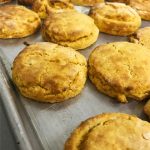
Primary sweet potato biscuits keep students warm on a cold morning.
At Greensboro Montessori School, Environmental Education Curriculum is based on seasonal cycles, the outdoor environment at the School, and the age of the students. We invite spontaneity and often pause to watch and identify insects, marvel at life in the garden, and discuss questions or insights as a community. In all levels we teach about soil, decomposition and compost, pollination, and biodiversity. But what is it we do in winter when the gardens are resting? The short answer is, we teach seasonality and ecology in organic gardens.
Primary students study birds, concentrating on basic identification by sight and sound. They love making binoculars (out of recycled toilet paper rolls) and using them on our bird walks around campus. Along the way, they learn to empathize with birds and their needs, to stop and slow down as not to miss a moment of wonder, and to make an ecological connection between our gardens and the needs of birds: shelter, food, water, and spaces to nest. As the weather warms up, we explore our winter stores of food from the fall gardens - sweet potatoes, garlic, ginger, and honey - in cooking classes, and venture outdoors to observe and relish in the signs of spring!
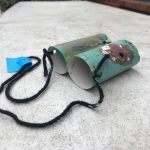
Lower Elementary students' binoculars are treasured tools in class this month.
Lower Elementary students delve even deeper into their bird study, concentrating not only on the basic identification of birds, but also on prolonged observation of bird behavior, habitat, and appreciation for their ecological significance in our organic, permaculture gardens. They love learning how to use and read field guides like ornithologists! I find bird study with this age is a wonderful way to remind children how to sit and soak in the surrounding environment, something we often don’t take time to do when the garden gets growing in spring. Bird watching in winter offers students opportunities to experience peace, critical thought, and insight that they so desperately need after the holiday rush and just before the end of year crunch! As spring break draws near, we share our bird findings with area scientists, cook with our winter food stores, and begin preparing ourselves for spring planting in the garden.
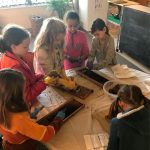
Upper Elementary students save bees wax from a hive that died over the winter. Honey bees and other native bees are a focal point for these students' climate change project.
Upper Elementary winter studies range from native tree and animal projects to redesigning of our Upper School outdoor classroom. This year, we're up to something BIG ... we’re tackling the subject of climate change and how it affects each of us and our experience at Greensboro Montessori School. We're thrilled the culmination of this project will include an art installation we collectively create and participation at the Student Climate Change Summit at UNCG on March 29. The event will be from 5 to 8 p.m. at Weatherspoon Art Museum. Open to the public, the Student Climate Change Summit will feature a wide-array of student participants representing several generations. In addition to our Upper Elementary students presenting their artwork, undergraduate students from UNCG will present research posters around a variety of climate change topics. A student from NC State will describe the work of The Climate Reality Project Campus Corps on their campus. Last but not least, students from the International Baccalaureate (IB) Program at Grimsley High School will present posters highlighting their IB papers on climate change. We hope you will join us at Weatherspoon Art Museum on March 29!
 About the Author
About the Author
Eliza Hudson is Greensboro Montessori School's lead environmental educator. Eliza holds her bachelor's degree in biology from Earlham College in Richmond, Ind. She has built and tended school gardens, taught hands-on cooking lessons and connected local farms to school programs working for FoodCorps. Prior to joining Greensboro Montessori School in 2014, Eliza was a classroom and after-school assistant at the Richmond Friends School, a farm intern at a family-owned farm in Ohio, and served as assistant director at a summer day camp in an urban community garden in Durham.
Greensboro Montessori School has taught environmental education since 1995 and has been permaculture gardening on its campus since 1997.
With Greensboro Montessori School's tuition payments dedicated to covering Greensboro Montessori School’s operating expenses, grants from the Annual Fund provide the necessary resources to make our School more than excellent - to make us truly exceptional. Through the benevolence of parents, alumni, community partners and friends of the School who give to the Annual Fund, Greensboro Montessori School is able to award grants biannually to teachers and students with specific classroom needs or transformative ideas or both!
Current year grants are funded by the previous year's giving. Contributions generously given and humbly received from last year's Annual Fund have begun taking shape through five grants awarded this fall. They range from simple classroom enhancements for our littlest students to significant technology investments for our elementary programs to supplies for creating a new ecosystem on campus (starring chickens) for our oldest scholars.
- Better Sleep for Growing Toddlers: The Academic-Day Toddler class received three new, high-quality Roman shades with blackout liners to help students get better sleep during nap time. While shades may seem simple to us, anything to promote sleep for our littlest students is transformative. The National Sleep Foundation says, "sleep is especially important for children as it directly impacts mental and physical development...During the deep states of [Non-Rapid Eye Movement] sleep, blood supply to the muscles is increased, energy is restored, tissue growth and repair occur, and important hormones are released for growth and development.
- Reading and Technology Resources for Lower Elementary: With four new Dell Chromebooks and a Raz-Kids subscription, the Lower Elementary program has increased access to age-appropriate, education-based technology. With dedicated laptops in the classroom, students will learn techniques for effective and safe online research and word processing skills. They will also be able to easily practice coding and have seamless access to their Raz-Kids online reading comprehension program. Furthermore, the use of PCs in Lower Elementary prepares students to be "bilingual" in the computer world. In many instances, we as adults use Apple products at home and PCs at work, or vice-versa, so ensuring our student have access to both platforms is important.
- iPads for Elementary Artists: In a continuation of Katherine Gwynn's exploration of the symbiotic relationship between creating with technology and hands-on art making, Greensboro Montessori School's art studio is now home to five iPad Airs and an iPad Pro. Students will integrate drawing, painting, digital photography, digital storytelling, animation and more through these new resources exclusive to our art curriculum.
- Chickens for Middle School Entrepreneurs: After 18 months of planning by students in the R&D (research and development) career track, the Middle School is developing a new ecosystem on campus for chickens. Working closely with Aubrey Cupit, Greensboro Montessori School's garden manager and owner of Gate City Harvest, Middle School students are building a mobile chicken coop, complete with a heat lamp, waterer and feeder for six chickens. Egg production will support the Land Lab, Maria's Café and other microeconomy programs. The coop will also include a technology cart with solar panels to power the coop's heat lamp. The mobile solar panels will also complement science lesson and provide a new power source at the Land.
- Ice for Bumps, Bruises, Food Prep, Entertaining and More: Until recently, we've been stocking our freezer with bags of ice. With a new industrial-grade ice maker, we've traded-out the ongoing cost of purchasing ice with a once-time cost to help us make it on our own (how Montessori of us)! The new ice maker supports the entire student-population ensuring a relatively unlimited supply of ice packs for minor student injuries. This resource will also keep our water and lemonade cold for guests at community events like the Fall Festival, Green & White Bash and End of the Year Pizza Party. Lastly, the Middle School will enjoy easy access to ice for Maria Café and trips to the Land.
Our fall grants are as varied as they are inspiring, but there are two things which bind them all. They are not only the result of giving, but also the reason for giving.
For everyone who has given in the past, is giving today or will give in the future, thank you for supporting Greensboro Montessori School. We are who we are because you have invested in us, and we promise to pay it forward by investing everything we can and all that we have in our students.
What do the oldest fabric in the world and a vintage typewriter have in common with my dentist? And what do they have to do with art? Well, I encountered each of them in the course of one week, and the intersection of these seemingly disparate things gave me an “a-ha” moment about the symbiotic relationship between creating with technology and hands-on art making in our School’s art studio.
As a mixed-media artist, I am naturally drawn to tactile, malleable, hands-on materials and adore using these materials in my lessons. If you walk into Greensboro Montessori School’s art studio, you will see a variety of rich textures, fibers, paints, clay, found objects and nature. You will also find a technology wall where one of the School’s 3D printers, a computers and iPads live. These two worlds co-exist harmoniously in our art studio and with each new day I am learning and teaching how technology and art are interwoven and applied in the world beyond the studio.
For instance, many Greensboro Montessori School faculty recently participated in an excellent coding workshop from Code.org. During this workshop I learned how coding is fun and creative and identified a great way to apply this technology in my classroom. Once armed with coding knowledge, students can practice their skills by writing an algorithm resulting in a specific design being drawn on their computer. They can bring this code to their art lesson and exchange it with another student. From there, students run each other’s algorithm to see if it produces what the creator originally intended.
Another project where technology and art intersect is stop motion animation. Students use a stop motion app on our classroom iPads to tell stories, but they also use physical objects make stop-motion animation the good old-fashioned way (by moving an object in small increments, taking photos of the object after each movement, and viewing multiple photos per second in a continuous sequence to create the illusion of motion). One of the most famous stop-motion animation films is the 1964 television special, Rudolph the Red-Nosed Reindeer. In our classroom, students manipulate KEVA planks, not wireframe figurines, to make their movies. The excitement has been great, and upper elementary students often rush back to class to ask Cathy Moses to come see their work!
Middle school students have been very helpful in teaching upper elementary students about the School’s 3D printer and 3D drawing program, SketchUp, which brings me back to my “a-ha” moment about the connection between art and technology. Within the course of one week at school I led a felting project demonstrating how to create with the oldest fabric in the world and guided lower elementary students in a freedom of speech exercise where they used a vintage typewriter to create art with their own words. I was reminded how each of these discoveries represented a technological shift at the time of their invention. At the end of the week, I went to the dentist and experienced a modern technology and art revolution in the making.
As crazy as it sounds, and as personal a story it is, my time at the dentist was real-world affirmation of the integration of art and technology. I was scheduled to get a crown and had anticipated my visit being the first of two required to complete the procedure, but then I was introduced to CAD/CAM (computer-aided design and computer-aided manufacturing) dentistry. While I was in the office, my dentist used technology to capture a 3D rendering of my tooth (CAD) and reproduce it onsite with a grinding and milling machine (CAM). While the grinding process used in my dentist’s office is different from the fabrication method used in 3D printing, the use of technology to produce sculpture in both cases highlights the inspirational interplay between technology and art. (And to top it all off, my ceramic crown was fired and glazed onsite, just like our students’ pottery is fired and glazed in our kiln!)
As we continue to create with our hands in collaborative and productive ways in Greensboro Montessori School's art studio, we will continue to grow the use of technology as well, because technology helps strengthen the development of our students 21st century skills and introduces them to career opportunities where art and technology co-exist.
If you are a parent of a Primary student then you may have wondered about the square pieces of paper with tracings of geometric shapes that your child brings home in her work folder. When she tells you what it is, you may ask her to repeat herself because it sounds like she is calling them "metal insects." Secretly, you think to yourself, "funny, these don't look anything like insects." And you would be right!
These designs are made with a fundamental Montessori material known as the Metal Insets.
The Metal Insets, predominantly found in the Primary and Lower Elementary classrooms, are used to develop a core set of skills that build upon one another in sequence. In the Primary classroom, this material is the first direct preparation for handwriting. The introduction to the Metal Insets usually follows a lot of indirect preparation for handwriting that is developed through the use of the Practical Life materials and the Sensorial materials (e.g. the three finger pincer grasp used with the small tongs, eye dropper, and knobbed cylinders aids the child in correct pencil grip).
Becoming proficient in using a writing instrument is a long process. When children work with the Metal Insets, they engage and practice a host of fine motor skills including lightness of touch, evenness of pressure, continuity of line, and control of line. Not to mention, this work also aids children in the development of concentration, memory and a sense of order (all necessary for executive function).
The physical material that is displayed on the shelf is both beautiful and organized in appearance. The Metal Inset materials consist of ten geometric shapes that each fit into a corresponding metal frame (like a puzzle piece). There are five straight-lined figures and five curve-lined figures: square, triangle, rectangle, pentagon, trapezium, circle, oval, ellipse, curvilinear triangle, and quatrefoil. The shapes correspond directly to the curves and angles found in the letters of the alphabet.
Beyond preparing and strengthening the hand for handwriting, there are 7 different presentations of Metal Insets that increase with difficulty starting with the simple tracing of shapes to the gradation, design and superimposition of shapes and colors. Lower Elementary students often revel in making intricate patterns by combining the shapes and observing their geometric proportions and relationships to one another, laying the foundation for true work in geometry.
Click here to learn more about the Metal Insets on www.montessoridaoshi.com
This summer I've been introduced to Montessori Market, a summer camp Greensboro Montessori has offered for the last 17 years. Through a unique blend of environmental education and hands-on learning, campers participate in a week-long business preparing consumer goods for sale to the general public at the conclusion of camp. Just as our 2016 graduating class impressed me, Montessori Market has revealed yet another School tradition which is so much more than meets the eye.
Montessori Market is an all-hands-on-deck camp featuring contributions from the entire school community. Whatever produce we can't harvest from our own permaculture gardens, we source from local farmers. Both faculty and students work together to gather ingredients before camp even begins. This year, Nancy Hofer, Mary Jacobson, Kristy Ford and Andi Bogan chaperoned our Lower Elementary Al Fresco summer camp students to a local blueberry farm where they hand picked blueberries for jam. We also needed peaches which led me to think about The Produce Box, a service which delivers fresh produce from North Carolina farmers to my doorstep each week. After one quick trip to Raleigh and the overwhelming generosity of The Produce Box, we had boxes of peaches, certified organic zucchini, green bell peppers, corn, jalapeños and tomatoes.
The students began camp with a full refrigerator of fresh, North Carolina-grown produce and three sprawling gardens from which to pick fresh basil for pesto and lavender for sachets. They have also made a wide variety of handmade crafts to accompany their foodstuffs.
As the students approach the end of the week, the most beautiful and compelling aspect of camp comes alive. With finished goods ready for sale, you have to wonder, "for whom and to whom will they sell their goods, and where?" I've since learned that Montessori Market has always worked for the benefit of children in need. Campers wake up bright and early to sell their products at the Greensboro Farmers Curb Market on the Saturday immediately following camp, and all proceeds are donated to a charity focused on kids. Hence, it's time to introduce BackPack Beginnings.
Founded six years ago by Parker White, a new mother at the time, BackPack Beginnings' mission is to deliver child-centric services to feed, comfort, and clothe children in need in Guilford County. By ensuring food and basic necessities are given directly to children in need, BackPack Beginnings makes a positive and lasting impact on their health and well-being. As a 100% volunteer organization, BackPack Beginnings serves over 6,000 children experiencing hunger and trauma in our community annually. Recently, Parker has been named one of four finalists for The NASCAR Foundation’s Sixth Annual Betty Jane France Humanitarian Award presented by Nationwide. This award honors incredible volunteers from across the country who have made a profound impact on children’s lives in their community. (You can vote for Parker daily from now until September 26; if she wins, The NASCAR Foundation will make a $100,000 donation to BackBack Beginnings.)
Our Montessori Market campers have been learning, cooking, and collaborating on behalf of BackPack Beginnings all week. This Saturday, July 30, they will be at the Curb Market proudly displaying their finished goods, and a donation to BackPack Beginnings will allow market-goers to shop from their products. In addition to the pesto and sachets, shoppers may also select from blueberry jam, peach jam, salsa, zucchini bread, and a number of homespun crafts.
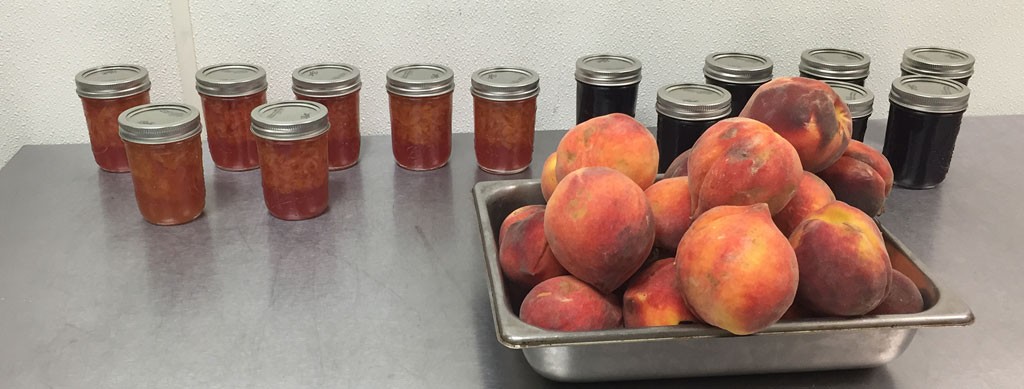
Peach and blueberry jams—lovingly made by students participating in Montessori Market—ready for display at the Greensboro Farmers Curb Market.
100% of the donations received on Saturday will assist the BackPack Beginnings' Food BackPack Program which helps fight childhood hunger in our community by filling the weekend food gap for children in need. By the numbers, this program sends 1,600 children from 26 schools with fresh food each weekend totaling 6,400 food bags per month. This effort is in addition to their Comfort BackPack, Food Pantry and Clothing Pantry programs. While our hope is that we receive enough donations on Saturday to empty our booth, any remaining products can be directly donated to BackPack Beginnings for direct inclusion in Food BackPacks or the Food Pantry.
So this is the story of how a summer camp evolves into so much more than a summer camp. How the Montessori philosophy challenges us, as adults, to push our kids to do more than text, snapchat and Netflix during summer break. How engaged faculty and community organizations prepare children for a lifetime of success by providing real-world experiences in running a business, manufacturing, time management, and philanthropy. And how children come together to help others less fortunate than themselves. And how Montessori Market is more than meets the eye.

